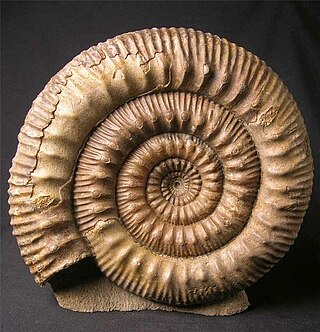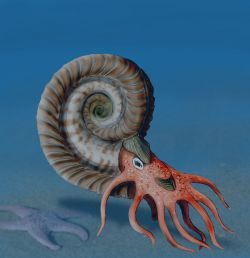
Parenthood is a 1989 American family comedy-drama film with an ensemble cast that includes Steve Martin, Tom Hulce, Rick Moranis, Martha Plimpton, Keanu Reeves, Jason Robards, Mary Steenburgen, and Dianne Wiest.

Dactylioceras was a widespread genus of ammonites from the Lower Jurassic period, approximately 180 million years ago (mya).

Clarence Bennett "C.B." Buckman was an American farmer, lumberman, and politician who served in the United States House of Representatives for Minnesota's 6th congressional district from 1903 to 1907. He also served in both houses of the Minnesota Legislature prior to his election to Congress.

Stephanoceras is an extinct genus of Stephanoceratoid ammonite which lived during the Bajocian. It is the type genus of the family Stephanoceratidae.
Fontannesia is an ammonoid cephalopod genus with a small to medium size, evolute, discoidal shell that was extant during the Jurassic Period. The sides are ribbed, the venter has a single median keel, and tubercles are lacking.
Dorsetensia is a narrowly coiled discoidal ammonite from the early Middle Jurassic, lower Bajocian, belonging to the family Sonniniidae of the superfamily Hildoceratoidea. The inner whorls are ribbed or smooth, outer whorl is smooth. The outer rim (venter) is narrow, with a keel running along the middle. The umbilicus, the opening in the middle of the shell exposing inner whorls, is of moderate size with a sharp, sometimes undercut edge.

Hyperlioceras is an extinct genus of cephalopod included in the ammonitid family Graphoceratidae that lived during the Bajocian stage of the Middle Jurassic. The type species is Hyperlioceras discites
Haplopleuroceras is a Middle Jurassic ammonite and likely member of the Hildoceratacean family Sonniniidae with which it shares the same sort of ribbing.
Guhsania is an extinct ammonoid cephalopod genus that lived during the early Middle Jurassic, from about 171.5 to 173.5 Ma.

Discinisca is a genus of brachiopods with fossils dating back from the Early Devonian to the Pliocene of Africa, Europe, North America, and New Zealand.
The Strigoceratidae is a family in the ammonitid superfamily Haploceratoidea, restricted to the lower Middle Jurassic, Bajocian stage, possibly derived from the Hammitoceratidae. The family was established and named by Buckman in 1924.

Oxynoticeratidae is a family of true ammonites included in the superfamily Psiloceratoidea.

Macrocephalites is a genus of the stephanoceratoid ammonite family Macrocephalitidae, diagnostic of the Callovian stage of the Middle Jurassic. Three subgenera, Dolikephalites, Kamptokephalites, and Pleurocephalites are recognized in addition to Macrocephalites itself, with Indocephalites tentatively included as the fourth.
Hammatoceratoidea, formerly Hammatocerataceae was a superfamily of middle Jurassic ammonites erected by Schindewolf in 1964 that combined the families Graphoceratidae, Hammatoceratidae, and Sonniniidae. The three families were previously included in the Hildoceratoidea, however subsequent classifications have moved the families back into Hildoceratoidea.

The family Dactylioceratidae comprises Early Jurassic ammonite genera with ribbed and commonly tuberculate shells that resembled later Middle Jurassic stephanoceratids and Upper Jurassic perisphinctids. Shells may be either evolute or involute.

Harpoceratinae is an extinct subfamily of cephalopods belonging to the family Hildoceratidae. Ammonites of this subfamily had involute and compressed shells with strong keels. Keel might be rarely missing, but this is considered to be an abnormality. This has been observed both in Cleviceras and Harpoceras and called as genus Monestieria, which is now known to be invalid. Another example is Pseudolioceras, whose unkeeled specimen was used as type for description of invalid genus Praehaploceras. Oxyconic forms of this subfamily does not have any keel. Ribs were single, but in some genera also bifurcating with shapes from sigmoidal to falcate. Sometimes, shell can have only striate ribs or is smooth. Tubercules are rare. Dimorphism is known in some genera and it is observable mostly in size. Macrochons can be 4, to 6 times larger than microconchs. As an example, macroconchs of Pseudolioceras are more than 150mm in diameter, while adult microconchs are only 35-50mm. There are big size differences even within dimorphs. Specimens ca be 2, or sometimes even 3 times bigger than other specimens of same dimorph.

Sydney Savory Buckman was a British palaeontologist and stratigrapher. He is known for his studies of extinct marine invertebrates, especially the Brachiopoda and Ammonoidea of the Jurassic era.

Hildoceratinae is an extinct subfamily of cephalopods belonging to the family Hildoceratidae. Ammonites of this subfamily had shells with elliptical or quadrate whorl section with keel or tricarinate, bisulcate venter. Ribs were variable, from falcate to strongly angled and from fine to strong. They can be interrupted by spiral groove in midlateral part of the shell. While some species can be smooth, strongly ribbed ones can have tubercules. Microconchs have short lapplets that is in its shape similar to the shape of growth lines in spiral midlateral groove.

Dumortieria is a genus of ammonites belonging to the family Graphoceratidae.

Tusk is a restaurant serving Mediterranean and Middle Eastern cuisine in Portland, Oregon's Buckman neighborhood, in the United States. The restaurant opened in 2016.













